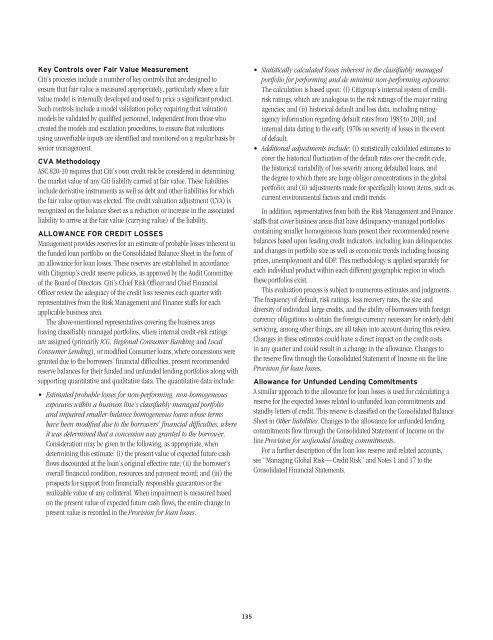Citigroup Inc.
Citigroup Inc.
Citigroup Inc.
You also want an ePaper? Increase the reach of your titles
YUMPU automatically turns print PDFs into web optimized ePapers that Google loves.
Key Controls over Fair Value MeasurementCiti’s processes include a number of key controls that are designed toensure that fair value is measured appropriately, particularly where a fairvalue model is internally developed and used to price a significant product.Such controls include a model validation policy requiring that valuationmodels be validated by qualified personnel, independent from those whocreated the models and escalation procedures, to ensure that valuationsusing unverifiable inputs are identified and monitored on a regular basis bysenior management.CVA MethodologyASC 820-10 requires that Citi’s own credit risk be considered in determiningthe market value of any Citi liability carried at fair value. These liabilitiesinclude derivative instruments as well as debt and other liabilities for whichthe fair value option was elected. The credit valuation adjustment (CVA) isrecognized on the balance sheet as a reduction or increase in the associatedliability to arrive at the fair value (carrying value) of the liability.ALLOWANCE FOR CREDIT LOSSESManagement provides reserves for an estimate of probable losses inherent inthe funded loan portfolio on the Consolidated Balance Sheet in the form ofan allowance for loan losses. These reserves are established in accordancewith <strong>Citigroup</strong>’s credit reserve policies, as approved by the Audit Committeeof the Board of Directors. Citi’s Chief Risk Officer and Chief FinancialOfficer review the adequacy of the credit loss reserves each quarter withrepresentatives from the Risk Management and Finance staffs for eachapplicable business area.The above-mentioned representatives covering the business areashaving classifiably managed portfolios, where internal credit-risk ratingsare assigned (primarily ICG, Regional Consumer Banking and LocalConsumer Lending), or modified Consumer loans, where concessions weregranted due to the borrowers’ financial difficulties, present recommendedreserve balances for their funded and unfunded lending portfolios along withsupporting quantitative and qualitative data. The quantitative data include:• Estimated probable losses for non-performing, non-homogeneousexposures within a business line’s classifiably managed portfolioand impaired smaller-balance homogeneous loans whose termshave been modified due to the borrowers’ financial difficulties, whereit was determined that a concession was granted to the borrower.Consideration may be given to the following, as appropriate, whendetermining this estimate: (i) the present value of expected future cashflows discounted at the loan’s original effective rate; (ii) the borrower’soverall financial condition, resources and payment record; and (iii) theprospects for support from financially responsible guarantors or therealizable value of any collateral. When impairment is measured basedon the present value of expected future cash flows, the entire change inpresent value is recorded in the Provision for loan losses.• Statistically calculated losses inherent in the classifiably managedportfolio for performing and de minimis non-performing exposures.The calculation is based upon: (i) <strong>Citigroup</strong>’s internal system of creditriskratings, which are analogous to the risk ratings of the major ratingagencies; and (ii) historical default and loss data, including ratingagencyinformation regarding default rates from 1983 to 2010, andinternal data dating to the early 1970s on severity of losses in the eventof default.• Additional adjustments include: (i) statistically calculated estimates tocover the historical fluctuation of the default rates over the credit cycle,the historical variability of loss severity among defaulted loans, andthe degree to which there are large obligor concentrations in the globalportfolio; and (ii) adjustments made for specifically known items, such ascurrent environmental factors and credit trends.In addition, representatives from both the Risk Management and Financestaffs that cover business areas that have delinquency-managed portfolioscontaining smaller homogeneous loans present their recommended reservebalances based upon leading credit indicators, including loan delinquenciesand changes in portfolio size as well as economic trends including housingprices, unemployment and GDP. This methodology is applied separately foreach individual product within each different geographic region in whichthese portfolios exist.This evaluation process is subject to numerous estimates and judgments.The frequency of default, risk ratings, loss recovery rates, the size anddiversity of individual large credits, and the ability of borrowers with foreigncurrency obligations to obtain the foreign currency necessary for orderly debtservicing, among other things, are all taken into account during this review.Changes in these estimates could have a direct impact on the credit costsin any quarter and could result in a change in the allowance. Changes tothe reserve flow through the Consolidated Statement of <strong>Inc</strong>ome on the lineProvision for loan losses.Allowance for Unfunded Lending CommitmentsA similar approach to the allowance for loan losses is used for calculating areserve for the expected losses related to unfunded loan commitments andstandby letters of credit. This reserve is classified on the Consolidated BalanceSheet in Other liabilities. Changes to the allowance for unfunded lendingcommitments flow through the Consolidated Statement of <strong>Inc</strong>ome on theline Provision for unfunded lending commitments.For a further description of the loan loss reserve and related accounts,see “Managing Global Risk—Credit Risk” and Notes 1 and 17 to theConsolidated Financial Statements.135
















